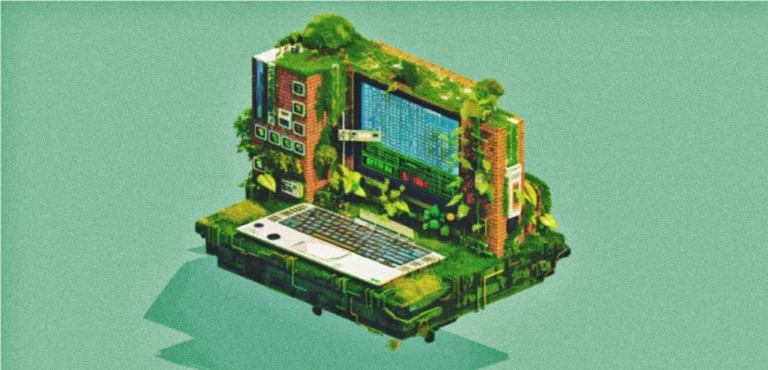
Green Computing is Saving the Planet, One Byte at a Time
Forget disposable coffee cups and carpooling – the eco-revolution is flourishing in the heart of data centres and server rooms. Green computing, the movement championing environmentally sustainable technology, has become a global rallying cry. From bustling startups in Bangalore to tech giants in London, a united front is forming in the fight against climate change.
Despite the desire for sustainability in tech, the real stats paint a concerning picture. Data centres, those insatiable digital behemoths, consume a staggering 2 percent of the world’s electricity – a figure exceeding the entire airline industry. Additionally, the e-waste tsunami sees millions of tonnes of outdated gadgets flooding landfills each year.
Inspired by the data, more companies are turning green. By embracing eco-friendly practices in their tech operations, companies across the globe are discovering a win-win scenario. Picture extending the lifespan of your servers, significantly reducing replacement costs, and sending e-waste packing. The benefits extend beyond tangible returns, fostering a happier workforce drawn to eco-conscious company culture and potentially attracting tax breaks from progressive governments.
How do you join the green computing crusade?
You don’t need to be in Silicon Valley to cast your eco-spell. Here are a few practical sustainability practices you can weave into your daily tech routine:
- Embrace cloud computing: Ditch the on-premise data centres that currently use 3% of all global energy consumption and migrate to cloud servers. Cloud providers like Google Cloud and Amazon Web Services are leading the charge in renewable energy and energy-efficient data centres.
- Unleash virtualization: By running multiple programs on a single server, you can significantly reduce energy consumption and minimise hardware waste. ]
- Monitor personal power use: These eco-gadgets are the ultimate energy assassins. They silently shut down unused devices and optimise energy usage, ensuring your server doesn’t waste a single watt.
- Seek Out Energy-Star Champions: Look for devices with Energy Star certifications – they’re typically 10-30% more efficient than standard models, leading the pack in efficiency. By choosing Energy Star certified products, you’ll save money on your electricity bills and reduce your environmental impact.
- Embrace E-Waste Redemption: Numerous companies offer responsible e-waste disposal and recycling programmes, offering your tech a dignified afterlife.Green IT isn’t a one-off choice – but a continuous battle against digital waste. Monitor your energy consumption diligently, embrace new eco-friendly solutions as they emerge, and keep an eye toward the evolving future of green computing.
The future of green computing: beyond the horizon
While current Green IT initiatives focus on reducing the environmental impact of existing technologies, the future leans toward developing of already-sustainable tech. Building in sustainability starts with materials in a circular economy approach. This involves designing products and systems that can be easily repaired, reused, and recycled, minimizing the need for virgin materials and reducing overall environmental impact. Imagine smartphones that are modular and easily upgraded, extending their lifespan and reducing the need for frequent replacements.
AI is poised to play a transformative role in green computing. AI algorithms can analyse data centre operations in real-time to optimize energy usage, predict potential issues, and automate maintenance procedures.
Software development practices are also evolving to become more eco-friendly. Developers are focusing on writing efficient code, using fewer resources, and minimizing the environmental footprint of software applications. This can involve techniques like code optimization, reducing unnecessary computations, and utilizing energy-efficient algorithms. By writing “greener” code developers can contribute significantly to green computing and sustainability efforts.
Individual actions for a sustainable future
While green computing initiatives at the corporate level are crucial, individual users also play a significant role in creating a sustainable digital future. Here are some simple yet impactful actions you can take.
Embrace a minimalist digital lifestyle
Regularly declutter your devices by uninstalling unused applications and deleting unnecessary files. This not only frees up storage space but also reduces the energy consumption of your devices, as less processing power is needed for a streamlined system.
Utilize energy-saving settings
Most devices come equipped with built-in power-saving options like automatic screen dimming, sleep mode, and low-power settings. Utilize these features whenever possible to further minimize your digital footprint.
Subscribe to our bi-weekly newsletter
Get the latest trends, insights, and strategies delivered straight to your inbox.
Extend device lifespan
Taking care of your gadgets extends their lifespan and reduces the need for frequent replacements, which in turn cuts down on e-waste generation. Invest in protective cases to safeguard your devices from physical damage, avoid exposing them to extreme temperatures, and keep the software updated for optimal performance and security. When it’s finally time to upgrade, make responsible e-purchase decisions.
Look for sustainable tech
Look for devices made from recycled materials with good energy efficiency ratings and long lifespans. Research reputable companies with take-back programs for old electronics, ensuring they are recycled responsibly.
Distilled
Green computing is a collective action and shared responsibility towards the health of our planet. By embracing eco-friendly practices, both individuals and corporations can significantly reduce the environmental footprint of the tech industry. As we move towards a future powered by technology, let’s ensure it’s a future powered by sustainable solutions, one byte at a time.